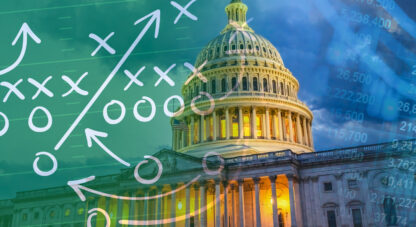A Match to the Powder Keg
Friday the 13th rarely lives up to its frightful hype, but this Friday’s iteration of the infamous day actually delivered. The Middle East is, unfortunately, a seemingly perpetual powder keg. This week, a match was lit. Now we’re all watching helplessly as that naked flame dances dangerously close to the devastatingly explosive material.
It’s unknown how events in the Middle East will unfold from here. It’s equally unknown what the full extent of the ramifications may be. What is clear is that this was an intensely disturbing week on the global political, social, economic, and financial front. Let’s dig in.
Over recent weeks, HAI has focused on supply-constrained energy markets, OPEC+’s newfound dominant oil pricing-power, and the resulting bull move in energy prices that acts as a wrench in the works of the global economic “goldilocks” narrative supporting relatively tranquil markets since the beginning of the year. Oil prices continue to threaten, but this week the bullish energy price dynamics may have become turbo-charged by unfolding developments in the Middle East.
Iranian oil is a crucial piece of the global oil supply picture. If Iran is involved in this burgeoning Middle East conflict, and if, one way or another, its oil exports are curtailed, an existing global supply problem will turn supply emergency. As it appears now, Iran is the major oil exporter most obviously in the potential crosshairs of disruptive hostility. However, the same dynamics apply to other major Middle East oil producers in the event of production disruption. The risk of material supply disruptions is rising fast, but the world can ill afford any disruptions to global oil supply—full stop.
Friday’s escalation of the Middle East threat for significantly expanded hostilities was clearly evident in financial market price action. Stocks sold off, oil prices surged, gold had one of its largest daily gains of the post-Covid era, and the VIX volatility “fear gage” index popped nearly 16%.
To be clear, and to reiterate, we don’t yet know how events in the Middle East and knock-on effects will develop. Nevertheless, given HAI’s market-centric mandate, it’s important to place the events of the week and some of the potential ramifications in the appropriate economic and financial context.
To begin with, this week’s update from the University of Michigan’s Surveys of Consumers told a most untimely tale. The latest preliminary October reading of the consumer sentiment index fell hard by 7.5% month-over-month (M/M) following two consecutive months of very little change. In addition, according to Surveys Director Joanne Hsu, “assessments of personal finances declined about 15%, primarily on a substantial increase in concerns over inflation, and one-year expected business conditions plunged about 19%.” Director Hsu also noted that, “nearly all demographic groups posted setbacks in sentiment, reflecting the continued weight of high prices.”
Reflecting that heightened concern over inflation, alarmingly, Hsu reported that, “Year-ahead inflation expectations rose from 3.2% last month to 3.8% this month.” That’s a huge jump for inflation expectations in just one month. The current reading is a reacceleration to the upside, the highest since May, and well above the pre-pandemic range. Meanwhile, long-run inflation expectations remain elevated relative to the 2.2–2.6% range seen in the two years pre-pandemic, and they also increased M/M from 2.8% to 3.0%.
In addition, survey scores for current economic conditions sunk by 6.6% M/M and are quickly returning toward cycle-low levels, while the index of consumer expectations plunged 8.0% M/M. Of further great concern, the number of consumers flagging high prices as the chief culprit for their worsening personal finances has completely reversed a year’s worth of progress and surged back to all-time highs matched previously only in 2022 and during the great financial crisis in 2008. Notably, all of this severe deterioration in the UMich consumer data was recorded, signed, sealed, and delivered before Friday the 13th’s decisive turn toward Middle East conflict escalation and broad-based surge of fear.
Obviously, despite the popular goldilocks narrative, the inflation fight is far from won, there is no “mission accomplished,” and oil prices now threaten to reverse any and all progress made on our serious consumer price problem. Far from victory over inflation or a path to perpetual goldilocks, the UMich results suggest two important and troubling alternative conclusions.
The first is that a rapidly weakening consumer is now showing signs of increased sensitivity to any further upward consumer price pressures when compared to previous points in this same inflation cycle. In this week’s data, high prices are clearly identified as problematic, and those high prices are now clearly manifest in a renewed erosion of consumer confidence, the consumer outlook, and in consumers’ perceptions of economic conditions. The takeaway is that the recent increase in oil prices is already delivering an outsized punch to the consumer. Any false steps in this Middle East minefield risk fully blowing the roof off of oil, gasoline, and energy prices broadly, and delivering what would now likely be a knockout blow to the consumer.
Second, we have not at all broken the back of still-elevated inflation expectations in the collective mind of the consumer. A yet-to-unfold deflationary recession would likely be required for that. As long as inflation expectations remain at high risk of being unanchored, consumer inflation psychology could develop at any time and rapidly intensify the upward price spiral in extreme and disorderly fashion. If events in the Middle East and energy prices broadly don’t cooperate, the global inflation ground war could escalate dramatically as the ramifications of much higher energy prices and inflation psychology both kick in overnight. In such an instance, our present goldilocks market narrative would likely be exposed as all too transitory and misguided, and ultimately little more than a comical footnote in the chronicles of the great unwind of history’s most prodigious financial asset bubble.
Again, in an attempt to tease out the potential economic and financial ramifications from this week’s tragic developments in the Middle East, it’s helpful to place current events in a proper context. In addition to the latest University of Michigan data, we can also turn to history and insights from Benjamin Anderson’s classic, “Economics and the Public Welfare: A Financial and Economic History of the United States, 1914-1946.” In this tour de force, Anderson describes, with eerie similarities to today’s set-up, the forces that led to the 1929 crash and Great Depression.
“The Federal Reserve System was created to finance a crisis… It was not created for the purpose of financing a boom, least of all for financing a stock market boom. But from early 1924 down to the spring of 1928 it was used to finance a boom and used to finance a stock market boom… Had the Federal Reserve System followed orthodox central bank tradition, using no discretion at all but merely obeying the rules, we should have averted the disasters that followed… At a time when unusual circumstances called for extra caution, they abandoned old standards and became daring innovators in the effort to play God.”
In Benjamin Anderson’s final analysis, the entire episode of central bank monetary policy malpractice “set the uncontrollable forces working which blew us up late in 1929.”
Starting in 2000, Federal Reserve policy became one of financing both stock market booms and crises alike. Rather than following orthodox central bank tradition and merely obeying the rules, modern central banks abandoned old standards and become the most daring financial innovators in history, even as every successive step along the way to where we find ourselves today called instead for extra caution.
At present, inflation, high interest rates, and the resulting rapid weakening of the consumer represent a clear and present economic threat. Now, in addition to the ongoing Russia/Ukraine war, we have the emerging potential for a full-blown Middle East clash that threatens to put the match to the energy, inflation, and—by extension—financial asset powder keg.
Meanwhile, after aggressively financing both booms and busts in stunning fashion for over 20 years, we now have record debt surpassing $33.5 trillion, deficits at $2 trillion, and interest alone at $1 trillion. Even in the perfect world envisioned by the Congressional Budget Office and its completely unrealistic estimates, our debt and deficits are still set to accelerate as far as the eye can see. Crucially, however, the bond market is already starting to revolt against such intense deficit spending. The sell-off of Treasurys and resulting spike in yields is threatening to initiate a debt doom-loop from which no easy or consequence-free exit is available.
It all prompts the question: what does the Federal Reserve have left in its arsenal to finance us out of a new crisis should one arrive now in full? If it tried its old stimulative tricks anew (zero interest rate policy and money printing) amid an inflationary environment and while the bond market is already protesting extreme deficit spending, would it work? Could it be done without cementing the path to crack-up-boom dynamics and a terminal fate of inflationary fire? At present, we must hope a real crisis doesn’t unfold; we must, and do, hope for the best; but frustratingly, we are reduced to hope.
HAI hopes profoundly that tensions fade, better angels emerge, and that the strength of character of good men and women rule the day. Again, though, that is a hope, and hope is not a strategy. As stated in weeks past, HAI fears that what prompted Churchill’s 1936 warning to the British House of Commons now pertains to us. We, too, are now at risk of “entering a period of consequences” following an endless era in which we did little more than aggressively extend and pretend on obviously unsustainable policies. If rather than a quick and favorable resolution, events in the Middle East gravitate instead toward a worst-case scenario, Friday the 13th could well mark the moment financial market goldilocks turned nightmare on Wall Street, and long-deferred consequences finally came home to roost. Unfortunately, under such ghoulish circumstances, it’s unclear if the Fed would have any silver bullets remaining for the occasion. At present, while seemingly vulnerable, unprepared, and weakened, we must hope that events in the Middle East don’t ultimately touch the match to the powder keg.
Weekly performance: The S&P 500 was up 0.45%. Gold was higher by 5.22%. Silver gained 5.43%, platinum was up 0.31%, and palladium was lower by 1.54%. The HUI gold miners index surged by 8.55%. The IFRA iShares US Infrastructure ETF was up 0.25%. Energy commodities were volatile and mixed on the week. WTI crude oil jumped 5.92%, while natural gas lost 3.06%. The CRB Commodity Index gained 2.55%, and copper dropped 1.65%. The Dow Jones US Specialty Real Estate Investment Trust Index was up 3.15%. The Vanguard Utilities ETF VPU was up 0.34%. The dollar index was higher by 0.61% to close the week at 106.43. The yield on the 10-yr U.S. Treasury was down 15 bps to end the week at 4.63%.
Best Regards,
Morgan Lewis
Investment Strategist & Co-Portfolio Manager
MWM LLC















